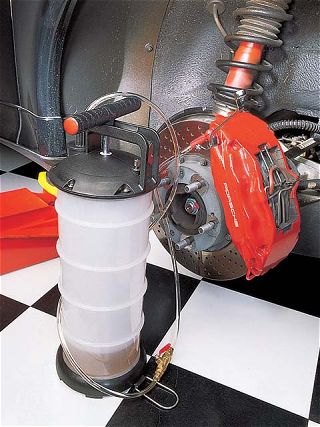 | Griot's Garage One-Man Brake Bleeder
| Griot's Garage One-Man Brake Bleeder
Brake fluid is hygroscopic, meaning it attracts water even inside the hydraulic system. This is why all European car manufacturers recommend a brake fluid change interval, usually 1 year or 2 years. Several brake fluid changing methods present themselves, and enthusiasts who will jump through flaming rings to avoid having to buy a tool have employed all manner of contraptions designed for other purposes, with predictable results. In my opinion, if you're going to do the job, you should do it right. And doing it right usually means having the right tools.
By changing brake fluid, I mean you are going to evacuate the master cylinder reservoir and replace all brake fluid in the brake hydraulic system and, if applicable, the clutch hydraulic system.
Generally speaking, there are three methods for changing brake fluid:
1. Pressure bleeding tools
2. Suction bleeding tools
3. Pumping the pedal (a crude variation of the pressure method)
I advise against the "pump the pedal" method for two reasons. First, it does not allow for evacuation of and removal of dirt from the master cylinder reservoir. Second, by pumping the pedal, it is very easy for the brake master cylinder piston to exceed its normal range of travel. If there is a bit of rust or dirt on the piston, and the piston exceeds its normal range of travel, damage to the seal and master cylinder failure can result. Moreover, it requires two people and takes a long time.
Pressure bleeders work better and have the advantage of being inexpensive tools for the most part. They also pressurize the system slightly to aid in clutch hydraulic work and guard against introduction of air into the system. If you introduce air into the system on a DSC or ABS car, it is entirely likely you'll have to make a trip to the dealer so they can cycle the ABS valves during a brake fluid change. However, pressure bleeders don't evacuate or remove dirt from the reservoir either, and there is a risk of contaminating the fresh brake fluid in the machine's holding tank and hoses.
My preference is for brake fluid suction tools. These require an air compressor, but as a practical matter anyone working on cars should have a compressor anyway. The suction tools allow the master cylinder reservoir to be vacuumed out using a piece of old brake pipe or similar implement. You then refill the reservoir with fresh brake fluid, and go to each caliper or wheel cylinder and use the tool to draw out the brake fluid until it runs clean through the clear hose. It's simple and fast. But, it's not cheap. The best suction tool I've ever seen is called a Vacula, which is made in Sweden. It costs about $188 from Griot's Garage (that's gree-ohs), which calls it a "One-Man Brake Bleeder."
Begin a brake fluid change by cleaning the exterior of the brake master cylinder reservoir with brake cleaner and a rag. Take a clean paper towel in one hand and remove the reservoir cap with the other. Lift the cup out of the reservoir and quickly place it in the paper towel. Put pressure against the bottom of the cup--there's a little hole in the bottom of it, and brake fluid will dribble out. Empty the cup and clean it out with brake cleaner. Blow it dry with compressed air if you have it.
Use the One-Man Brake Bleeder to evacuate the brake master cylinder by inserting an old piece of brake pipe in the nipple on the end of the hose. Then fill the reservoir with fresh brake fluid. With this tool, the rest is easy. Just go to each brake caliper bleeder and use the One-Man Brake Bleeder to draw out the old brake fluid until you see new, clear brake fluid running through the hose. Close the bleeder valve, remove the hose, open the valve a bit until a drop of brake fluid appears (this will make sure there isn't a small air bubble at the top of the caliper), then close it again, replace the dust cap and move to the next caliper. After each caliper is bled, top off the reservoir with brake fluid. The One-Man Brake Bleeder is a pricey tool commitment, but versus paying someone to change your brake fluid, and the attendant hassle of getting the car there and picking it up later, the tool pays for itself quickly.
Now, there are lots of brake bleeding tools out there, from suction pumps you have to squeeze 10,000 times to do the job, to units that use tire air pressure to drain brake fluid while flattening the tire, to your Aunt Selma's breast pump duct taped to a turkey baster with a piece of old emissions vacuum hose held on with a zip tie. Save the letters, please--we're telling you about the best tool, not the only tool!
